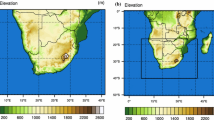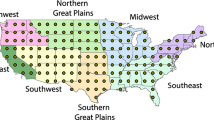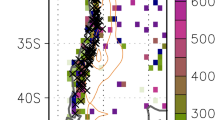Abstract
A 108-year (1901–2008) downscaling of the twentieth-century reanalysis (20CR) using the Regional Spectral Model (RSM) has been conducted for the southeastern United States (SEUS) at a horizontal grid resolution of 10 km. This 108-year product, named as the Florida Climate Institute-Florida State University Land–Atmosphere Reanalysis for the southeastern United States at 10-km resolution version 1.0 [FLAReS1.0], has primarily been developed for anticipated application studies in hydrology, crop management, ecology, and other interdisciplinary fields in the SEUS. The analysis of this downscaled product reveals that it ameliorates the issue of artificial discontinuity in the precipitation time series of the 20CR from the variations inherent to RSM. This centennial scale product allows us to begin examining decadal scale variations of the regional features of the SEUS. The fidelity of the low-frequency variations of the winter rainfall associated with the Atlantic Multi-decadal Oscillation (AMO) and the Pacific Decadal Oscillation is reasonably well captured in FLAReS1.0. In fact, the modulation of the El Niño-Southern Oscillation (ENSO) teleconnection with the SEUS rainfall by AMO in the downscaled product is also validated with observations. The ENSO-associated variations of accumulated rainfall from landfalling hurricanes in the SEUS are also well simulated in the downscaled climate simulation. It is to be noted that the success of this dynamical downscaling is also because the global reanalysis of 20CR showed comparable fidelity in these low-frequency variations of the SEUS climate. This method of dynamic downscaling global reanalysis with inclusion of spectral nudging at large wavelengths (in this case ≥500 km) toward the driving global reanalysis (20CR) is sometimes referred as a form of regional reanalysis.




Similar content being viewed by others
References
Bastola S, Misra V (2012) Evaluation of dynamically downscaled reanalysis precipitation data for hydrological application of watersheds in the southeast United States. Hydrol Process. Submitted
Bove MC, Elsner JB, Landsea CW, Niu X, O’Brien JJ (1998) Effects of El Niño on US landfalling hurricanes, revisited. Bull. Am Meteor Soc 79:2477–2482
Cane MA, Zebiak SE (1985) A theory for El Niño and the Southern Oscillation. Science 228:1085–1087
Castro CL, Pielke RA Sr, Leoncini G (2005) Dynamical downscaling: assessment of value retained and added using the regional atmospheric modeling system (RAMS). J Geophys Res 110:D05108. doi:10.1029/2004JD004721
Chen F, Dudhia J (2001) Coupling an advanced land-surface hydrology model with the Penn State/NCAR MM5 modeling system. Part I: model implementation and sensitivity. Mon Wea Rev 129:569–585
Chou MD, Suarez MJ (1994) An efficient thermal infrared radiation parameterization for use in general circulation models. Technical report series on global modeling and data assimilation, NASA/TM-1994-104606, 3, 85 pp
Chou M-D, Suarez MJ, Ho C-H, Yan MM-J, Lee K-T (1998) Parameterizations for cloud overlapping and shortwave single-scattering properties for use in general circulation and cloud ensemble models. J Climate 11:202–214
Compo GP et al (2011) The twentieth century reanalysis project. Q J R Meteorol Soc 137:1–28
DiNapoli S, Misra V (2012) Reconstructing the 20th century high-resolution climate of the Southeastern United States. J Geophys Res (Atmospheres) 117:D19113. doi:10.1029/2012JD018303
Efron B, Tibshirani RJ (1993) An introduction to the bootstrap. Chapman and Hall, London
Enfield DB, Mestaz-Nunez AM, Trimble PJ (2001) The Atlantic multidecadal oscillation and its relation to rainfall and river flows in the continental US. Geophys Res Lett 28:2077–2080
Ferguson CR, Villarini G (2012) Detecting inhomogeneities in the twentieth century reanalysis over the central United States. J Geophys Res 117:D05123. doi:10.1029/2011JD016988
Gershunov A, Barnett TP (1998) Interdecadal modulation of ENSO teleconnections. Bull Am Meteorol Soc 80:2715–2725
Gibson W et al (2002) Development of a 103-year high-resolution climate data set for the conterminous United States. In: Proceedings of 13th American meteorological society conference on applied climatology, Portland, OR, pp 181–183
Gray WM (1984) Atlantic seasonal hurricane frequency. Part I:El Nin˜o and 30 mb quasi-biennial oscillation influences. Mon Wea Rev 112:1649–1668
Guilyardi E, Wittenberg A, Fedorov A, Collins M, Wang C, Capotondi A, von Oldengorgh GJ, Stockdale T (2009) Understanding El Niño in ocean–atmosphere general circulation models: progress and challenges. Bull Am Meteorol Soc 90:325–340
Guilyardi E, Cai W, Collins M, Fedorov A, Jin F-F, Kumar A, Sun D-Z, Wittenberg A (2012) New strategies for evaluating ENSO processes in climate models. Bull Am Meteorol Soc 93:235–238
Higgins RW, Shi W, Yarosh E, Joyce R (2000) Improved United States precipitation quality control system and analysis. NCEP/CPC ATLAS No. 7. Also available at: http://www.cpc.ncep.noaa.gov/research_papers/ncep_cpc_atlas/7/index.html
Hong S-Y, Pan H-L (1996) Nonlocal boundary layer vertical diffusion in a medium-range forecast model. Mon Wea Rev 124:2322–2339
Kanamaru H, Kanamitsu M (2007) Scale-selective bias correction in a downscaling of global analysis using a regional model. Mon Wea Rev 135:334–350
Kanamitsu M, Ebisuzaki W, Woollen J, Yang S-K, Hnilo JJ, Fiorino M, Potter GL (2002) NCEP-DOE AMIP-II reanalysis (R-2). Bull Am Meteor Soc 83:1631–1643
Kanamitsu M, Yoshimura K, Yhang Y-B, Hong S-Y (2010) Errors of interannual variability and multi-decadal trend in dynamical regional climate downscaling and its corrections. J Geophys Res 115:D17115. doi:10.1029/2009JD013511
Kerr RA (2000) A North Atlantic climate pacemaker for the centuries. Science 288:1984–1986
Klotzbach PJ (2011) El Niño-southern oscillation’s impact on Atlantic Basin Hurricanes and US. Landfalls J Climate 24:1252–1263
Mantua NJ, Hare SR, Zhang Y, Wallace JM, Francis R (1997) A Pacific interdecadal climate oscillation with impacts on salmon production. Bull Am Meteorol Soc 78:1069–1079
McClave JT, Dietrich FH II (1994) Statistics. MacMillan College Publishing Co, New York
Mearns LO, Gutowski WJ, Jones R, Leung L-Y, McGinnis S, Nunes AMB, Qian Y (2009) A regional climate change assessment program for North America. EOS Trans. 90:311–312
Mingfang T, Kushnir Y, Seager R, Li C (2009) Forced and internal twentieth-century SST trends in the North Atlantic. J Climate 22:1469–1481. doi:10.1175/2008JCLI2561.1
Misra V, Moeller L, Stefanova L, Chan S, O’Brien JJ, Smith III TJ, Plant N (2011) The influence of the Atlantic Warm Pool on the Florida panhandle sea breeze. J Geophys Res 116:D00Q06. doi:10.1029/2010JD015367
Mo KC (2010) Interdecadal modulation of the impact of ENSO on precipitation and temperature over the United States. J Climate 23:3639–3656
Newman M, Compo GP, Alexander MA (2003) ENSO-forced variability of the Pacific decadal oscillation. J Climate 16:3853–3857
Pan H-L, Wu W-S (1994) Implementing a mass-flux convective parameterization package for the NMC medium range forecast model. Preprints, 10th conference on numerical weather prediction, Portland, OR, American Meteorological Society, pp 96–98
Pettitt AN (1979) A non-parametric approach to the change-point problem. Appl Stat 28:126–135. doi:10.2307/2346729
Philander SG (1990) El Niño, La Niña, and the Southern Oscillation. Academic Press, San Diego, CA
Rayner NA, Parker DE, Horton EB, Folland CK, Alexander LV, Rowell DP, Kent EC, Kaplan A (2003) Global analysis of sea surface temperature, sea ice, and night marine air temperature since the late nineteenth century. J Geophys Res 108:4407. doi:10.1029/2002JD002670
Richards TS, O’Brien JJ (1996) The effect of El Niño on US landfalling hurricanes. Bull Am Meteor Soc 77:773–774
Shimpo A, Kanamitsu M, Iacobellis SF, Hong S-Y (2008) Comparison of four cloud schemes in simulating the seasonal mean field forced by the observed sea surface temperature. Mon Wea Rev 136:2557–2575
Slingo JM (1987) The development and verification of a cloud prediction scheme for the ECMWF model. Q J R Meteorol Soc 113:899–927
Smith SR, Brolley J, O’Brien JJ, Tartaglione CA (2007) ENSO’s impact on regional US hurricane activity. J Climate 20:1404–1414
Stefanova L, Misra V, Chan S, O’Brien JJ, Smith TJ III (2012) A proxy for high resolution regional reanalysis for the Southeast United States: assessment of precipitation variability. Climate Dyn 38:2449–2466
Tartaglione CA, Smith SR, O’Brien JJ (2003) ENSO impact on hurricane landfall probabilities for the Caribbean. J Climate 16:2925–2931
Tiedtke M (1993) Representation of clouds in large-scale models. Mon Wea Rev 121:3040–3061
von Storch H, Langenberg H, Feser F (2000) A spectral nudging technique for dynamic downscaling purposes. Mon Wea Rev 128:3664–3673
Uppala SM et al (2006) The ERA40 re-analysis. Q J R Meteorol Soc. doi:10.1256/qj.04.176
Whitaker JS, Hamill TM (2002) Ensemble data assimilation without perturbed observations. Mon Wea Rev 130:1913–1924
Yoshimura K, Kanamitsu M, Dettinger M (2010) Regional downscaling for stable water isotopes: a case study of an atmospheric river event. J Geophys Res 115:D18114
Acknowledgments
This work was supported by grants from NOAA (NA07OAR4310221), USGS (06HQGR0125), and USDA (027865). Its contents are solely the responsibility of the authors and do not necessarily represent the official views of the acknowledged funding agencies.
Author information
Authors and Affiliations
Corresponding author
Electronic supplementary material
Below is the link to the electronic supplementary material.
Rights and permissions
About this article
Cite this article
Misra, V., DiNapoli, S.M. & Bastola, S. Dynamic downscaling of the twentieth-century reanalysis over the southeastern United States. Reg Environ Change 13 (Suppl 1), 15–23 (2013). https://doi.org/10.1007/s10113-012-0372-8
Received:
Accepted:
Published:
Issue Date:
DOI: https://doi.org/10.1007/s10113-012-0372-8




